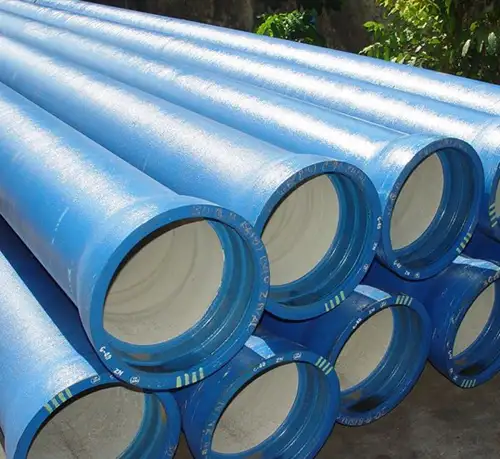Ductile iron pipe traces its origins to the mid-20th century, following the discovery of ductile iron in 1943 by Keith Millis. After experimental castings in 1948, a U.S. patent was granted in 1949, and the first commercial installations appeared in 1955 in North America. In parallel, Japan’s Kubota company commercialized its own process in 1954, and major manufacturers like ACIPCO began shipping ductile iron pipe in 1955. Sporadic use from the mid-1950s gave way to widespread adoption by the late 1970s, firmly supplanting gray cast iron in water and wastewater systems.

Introduction
Ductile iron pipe—a form of nodular graphite cast iron—offers the strength of steel combined with enhanced ductility, making it ideal for potable water, sewer, and industrial fluid conveyance. Understanding when it was first used helps engineers appreciate its rapid rise to dominance over traditional gray iron pipe.
Invention & Early Experiments
Discovery of Ductile Iron
American metallurgist Keith Dwight Millis first observed spheroidal graphite formation in molten iron in 1943, aiming to replace scarce chromium in wartime alloys.
First Experimental Pipe Production
The initial ductile iron pipe castings were produced on a trial basis in 1948, demonstrating the material’s capacity to bend without fracturing.
Patent & Commercial Development
U.S. Patent (1949)
On October 25, 1949, Millis and colleagues received U.S. Patent 2,485,760 for a magnesium-treated ferrous alloy that formed nodular graphite, marking the official recognition of ductile iron technology.
First Commercial Introduction in North America (1955)
Ductile iron pipe was introduced to the commercial marketplace in 1955, quickly earning a reputation for strength, durability, and long service life in water and wastewater systems.
-
ACIPCO (American Cast Iron Pipe Company) shipped their first large orders of ductile iron pipe in 1955, leveraging new melting and casting processes to scale production.
-
DIPRA recognizes 1955 as the year ductile iron pipe set the industry standard for modern infrastructure.
Global Commercialization
| Region | Year | Milestone |
|---|---|---|
| Germany | 1455 | First known iron pipe installation at Dillenberg Castle (gray cast iron) |
| United States | 1943 | Discovery of ductile iron (Millis) |
| 1948 | First experimental ductile iron pipe castings | |
| 1949 | U.S. patent granted for nodular graphite iron | |
| 1955 | Commercial launch and first shipments of ductile iron pipe (ACIPCO, DIPRA) | |
| Japan | 1954 | Kubota commercialized a vertical-blow static casting method for ductile iron pipe |
| Worldwide | Late 1970s | Ductile iron pipe becomes preferred over gray iron in nearly all active pipe production |
Adoption Timeline
Ductile iron pipe’s field deployment evolved through phases:
-
Mid-1950s: Sporadic, “experimental” installations as rubber-gasket joints and new grade classes were introduced.
-
Late 1960s–Early 1970s: Co-production of gray and ductile iron at foundries; industry learns to distinguish the two materials.
-
Late 1970s: Ductile iron pipe supplants gray cast iron as the preferred material, driven by superior mechanical properties and standardized pressure classes.
Frequently Asked Questions
Q1: Why was ductile iron pipe not used before the 1950s?
A1: Prior to Millis’s discovery of spheroidal graphite in 1943, iron pipe microstructures contained flake graphite, which made them brittle and unsuitable for demanding pressure applications.
Q2: How did patent 2,485,760 influence pipe production?
A2: The 1949 patent codified the magnesium-treatment process, enabling foundries to produce consistent nodular graphite and thus reliable ductile iron pipe grades.
Q3: What advantages led to ductile iron’s rapid adoption after 1955?
A3: Compared to gray iron, ductile iron offered two-to-four times the tensile strength, higher elongation, and improved impact resistance, extending infrastructure lifespans beyond 100 years.
Q4: Were there regional differences in adoption?
A4: Yes—while North America saw its first commercial shipments in 1955, Japan’s Kubota had commercially cast ductile iron pipe by 1954, and Europe standardized its own grades in the 1960s.
Q5: Can existing gray iron mains be replaced with ductile iron pipe?
A5: Absolutely—modern trenchless techniques and compatible bell-and-spigot joints allow utilities to upgrade without major excavation, leveraging ductile iron’s superior performance.
References:
- Ductile Iron – Wikipedia (History and Properties)
- U.S. Patent 2,485,760 – Magnesium Treatment for Nodular Graphite Iron (1949)
- DIPRA – Ductile Iron Pipe Research Association: Industry History and Standards
- Kubota Corporation – Ductile Iron Pipe Production History
- ACIPCO – American Cast Iron Pipe Company History and Innovations

